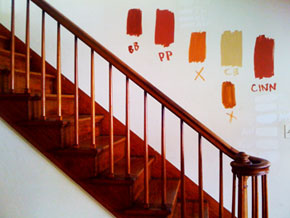Burning Bush, Pizza Pie, Indian Paintbrush, Wild Plum, Heirloom Lace

There's a persistent urban myth that Eskimos have at least 50 names for snow. That may have been debunked, but I'm pretty sure there's another group in the running for Most Names for One Thing: paint companies. They have developed at least a thousand names for the color white: moonlit snow, colonial white, diamond mine, combed cotton, capri cream, vanilla wafer, linen ruffle, mother of pearl, heirloom lace—the list goes on and on.
I went through 13 shades of white, four shades of pink, five shades of red, two shades of plum and eight shades of orangey-rust colors to achieve my final palate (some of which are listed in the title of this piece). I looked at my artwork, my floor rugs and the hues of my plants. I pulled colors from all those places, as well as from the book Mexican Color.
While picking the colors was difficult, picking the paint was easy. I went back to what I knew would work.
When I moved to Kansas three years ago, I was determined to use a zero-VOC paint that would not give off harmful volatile organic compounds. (Take a look at my last article on flooring, for the low-down on VOCs and why they should be avoided.)
VOCs are known to add to indoor air pollution and contribute to (or trigger) a host of problems, ranging from skin allergies to headaches to possibly cancer. Zero-VOC paints contain fewer than 5 grams of VOCs per liter. (That ratio really refers to the base paint. Most pigments contain a higher percentage of VOCs, don't link this one but are still significantly better for your health and the planet than traditional paints.)
As with most things, paints exist on a continuum. The most eco-friendly paints, like Real Milk Paint and BioShield Paint, are made from substances like milk casein or clay. They are incredible, but may require more money and greater preparation—and are not readily available in my area, so were not on my original list. (If I had chemical sensitivities, I would seek them out or source the natural paints on this list.
I went through 13 shades of white, four shades of pink, five shades of red, two shades of plum and eight shades of orangey-rust colors to achieve my final palate (some of which are listed in the title of this piece). I looked at my artwork, my floor rugs and the hues of my plants. I pulled colors from all those places, as well as from the book Mexican Color.
While picking the colors was difficult, picking the paint was easy. I went back to what I knew would work.
When I moved to Kansas three years ago, I was determined to use a zero-VOC paint that would not give off harmful volatile organic compounds. (Take a look at my last article on flooring, for the low-down on VOCs and why they should be avoided.)
VOCs are known to add to indoor air pollution and contribute to (or trigger) a host of problems, ranging from skin allergies to headaches to possibly cancer. Zero-VOC paints contain fewer than 5 grams of VOCs per liter. (That ratio really refers to the base paint. Most pigments contain a higher percentage of VOCs, don't link this one but are still significantly better for your health and the planet than traditional paints.)
As with most things, paints exist on a continuum. The most eco-friendly paints, like Real Milk Paint and BioShield Paint, are made from substances like milk casein or clay. They are incredible, but may require more money and greater preparation—and are not readily available in my area, so were not on my original list. (If I had chemical sensitivities, I would seek them out or source the natural paints on this list.
Simran Sethi is an award-winning journalist and associate professor at the University of Kansas School of Journalism and Mass Communications. For more information on Sethi, visit www.simransethi.com.



